A good mornings walk into the Hills and a drive along the Hecho Valley.
Deb and Ian, Day Forty Five.
Ebird List for Gabardito and Salto de la Vieja walk.
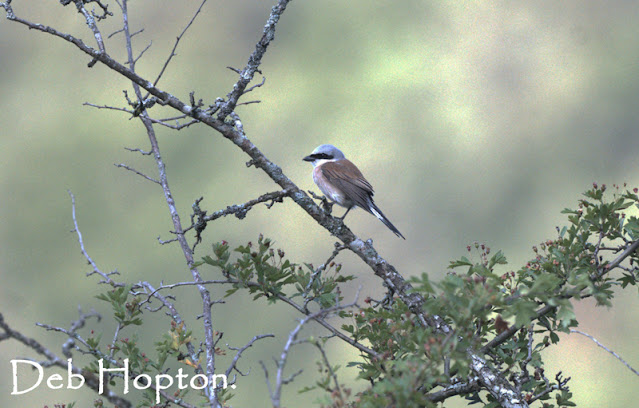 |
| Red-backed Shrike (Alcaudón Dorsirrojo / Lanius collurio). |
We headed off quite early as we thought the area around Gabardito would be swamped with walkers but we were pleasantly surprised how quiet it was, as we turned off the road to the North of Hecho and started to drive up to the Refugio we made a stop amongst the camper vans and watched a couple of
Red-backed Shrike (Alcaudón Dorsirrojo / Lanius collurio) which was a nice start to the day.
We drove up to the car park at the top of the road which has a sign at the entrance say no over night stopping and parked amongst the camper-vans, as we were getting our kit together we heard and saw Great Spotted Woodpecker (Pico Picapinos / Dendrocopos major), Eurasian Jay (Arrendajo Euroasiático / Garrulus glandarius), Eurasian Blackcap (Curruca Capirotada / Curruca capirotada), Western Bonelli's Warbler (Mosquitero Papialbo / Phylloscopus bonelli), 2x Eurasian Bullfinch (Camachuelo Común / Pyrrhula pyrrhula) and then I heard a Eurasian Treecreeper (Agateador Euroasiatico / Certhia familiaris) sing not too far into the Pines so we went in to try and find it.
Rant.
Fortunately we saw the bird a short way into the woods, just as we were walking in one of the occupants from the camper-vans was walking out carrying his loo roll giving away the fact that he had obviously been in there for a crap and as we looked around the spot, going by the amount of discarded paper it was very clear that the woods are the main toilet for the camper-van people who shouldn't be there over night in the first place.
Most of these people are walkers who come here to visit a beautiful area and then disrespect it totally by treating it in this way and making it very unpleasant for visitors who use the place correctly and what is even more annoying is that there are at least 3 proper Camping / Camper-van sites within a few KMs of the spot.
Rant over.
 |
| The view from near the car park. |
We started to do the walk out from the car park and soon found Common Columbine (Aquilegia vulgaris),
Common Chiffchaff (Mosquitero Común / Phylloscopus collybita) and once we were on the main track out through the woods we added Short-toed Treecreeper (Agateador Europeo / Certhia brachydactyla),
Coal Tit (Carbonero Garrapinos / Periparus ater),
Song Thrush (Zorzal Común / Turdus philomelos),
Common Blackbird (Mirlo Común / Turdus merula),
European Robin (Petirrojo Europeo / Erithacus rubecula) and after a few 100 meter we heard what we realised straight away was a drumming
Black Woodpecker (Picamaderos Negro / Dryocopus martius) and after a few minutes of searching we had brief views of the bird as it flew off through the Pines.
 |
| Common Columbine (Aquilegia vulgaris). |
We continued on out to the spot where in the past I have seen a
Wallcreeper (Treparriscos / Tichodroma muraria) along the cliffs, on the way we had
Egyptian (Alimoche Común / Neophron percnopterus) and
Griffon Vulture (Bultre Leonado / Gyps fulvus), Eurasian Sparrowhawk (Gavilán Común / Accipiter nisus),
Red-billed Chough (Chova Piquirroja / Pyrrhocorax pyrrhocorax),
European Crested Tit (Herrerillo Capuchino / Lophophanes cristatus),
Eurasian Nuthatch (Trepador Azul / Sitta europaea), Duke of Burgundy (Sword-leaved Helleborine (Cephalanatera longifolia),
Elder-flowered Orchid (Dactylorhiza sambucina),
Fairy Foxglove (Erinus alpinus), Green Hellebore (Helleborus viridis) and
White Rockrose (Helianthemum apenninum).
 |
| Duke of Burgundy ( |
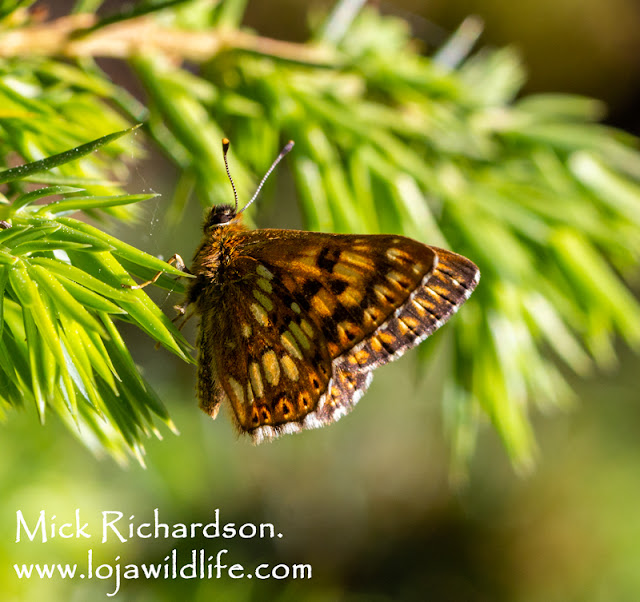 |
| Duke of Burgundy ( |
 |
| Duke of Burgundy ( |
 |
| Sword-leaved Helleborine (Cephalanatera longifolia). |
 |
| Elder-flowered Orchid (Dactylorhiza sambucina). |
At the spot we were heading for was sat down on the track and waited to see what turned up, species included
Bearded Vulture (Quebrantahuesos / Gypaetus barbatus),
Booted Eagle (Aguila Calzada / Aquila penntuas) dark morph, Iberian Green Woodpecker (Pito ibérico / Picus sharpei),
European Crested Tit (Herrerillo Capuchino / Lophophanes cristatus),
Western House (Avión Común Occidental / Delichon urbicum) and
Eurasian Crag Martin (Avión Roquero / Ptyonoprogne rupestris),
Mistle Thrush (Zorzal Charlo / Turdus viscivorus), Black Redstart (Colirrojo Tizón / Phoenicurus ochruros), Eurasian Wren (Chochin paleártico / Troglodytes troglodytes),
Great (Carbonera Común / Parus major) and Eurasian Blue Tit (Herrerillo Común / Cyanistes caeruleus). |
| The crags where the Bearded Vultures (Quebrantahuesos / Gypaetus barbatus) were cruising around. |
 |
| Egyptian Vulture (Alimoche Común / Neophron percnopterus). |
 |
| Griffon Vulture (Bultre Leonado / Gyps fulvus). |
 |
| Griffon Vulture (Bultre Leonado / Gyps fulvus). |
After a while we decided to continue on and head out onto the Alpine meadows above the cliff, the last bit of the walk was in much worse condition than the last time I was there but we took our time and reached the tops safely, out in this area which was mostly nice open grassland with the odd small bush we found
Alpine Marmot (Marmota marmota), Dunnock (Acentor Común / Prunella modularis),
White Wagtail (Lavandera Blanca / Montacilla alba) and
Yellowhammer (Escribano Cerillo / Emberiza citronella). |
| The upper meadows. |
 |
Alpine Marmot (Marmota marmota). |
 |
| Deptford Pink (Dianthus armeria). |
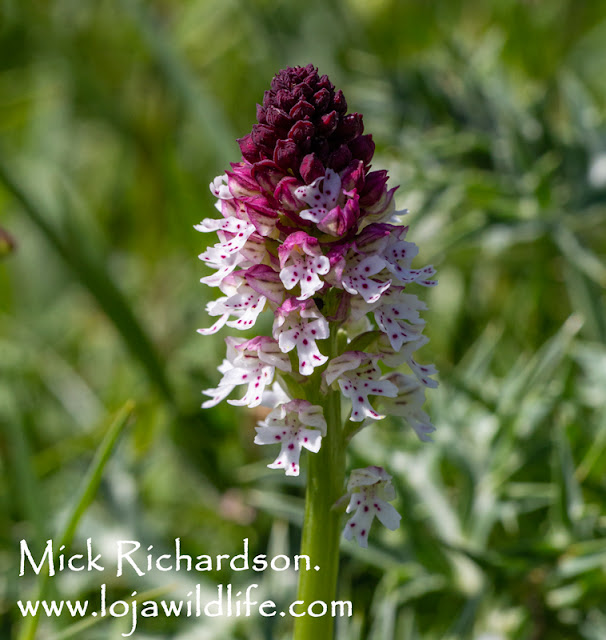 |
| Burnt Orchid (Neotinea Ustulata). |
 |
| Continental Striped Shield Bug (Graphosoma italicum ssp. italicum). |
There were good numbers of plants including Horminum pyrenaicum, Lady's Bedstraw (Galium verum), Deptford Pink (Dianthus armeria),
Alpine Lady's Mantle (Alchemilla alpina), Burnt Orchid (Neotinea Ustulata), Fragrant Orchid (Gymnadenia conopsea),
Psilothrix viridicoerulea????
Common (Polyommatus icarus),
Small (Cupido minimus) and
Mazarine Blue (Cyaniris semiargus), Glanville Fritillary (Melitaea cinxia), Small Tortoiseshell (Aglais urticae),
Continental Striped Shield Bug (Graphosoma italicum ssp. italicum),  |
| Mazarine Blue (Cyaniris semiargus). |
 |
| Mazarine Blue (Cyaniris semiargus). |
 |
| Small Blue (Cupido minimus). |
 |
| Small White (Pieris rapae). |
 |
| Small White (Pieris rapae). |
As we dropped back down the rough bit of track we photographed some of the stuff we saw on the way up which included
Pyrenean Saxifrage (Saxifraga longifolia),
Wild Grape Hyacinth (
Muscari neglectum), Lebelloides hispanicus,
Small White (
Pieris rapae),
Small Copper (Lycaena phlaeas) and
Clouded Yellow (Colias croceus).
 |
| Common Blue (Polyommatus icarus). |
 |
| Glanville Fritillary (Melitaea cinxia). |
 |
| Glanville Fritillary (Melitaea cinxia). |
 |
| Dingy Skipper (Erynnis tages). |
 |
| Deb with a friendly Small Tortoiseshell (Aglais urticae) which followed s for ages. |
 |
| Psilothrix viridicoerulea ???? |
 |
| Greater Butterfly Orchid (Platanthera chlorantha). |
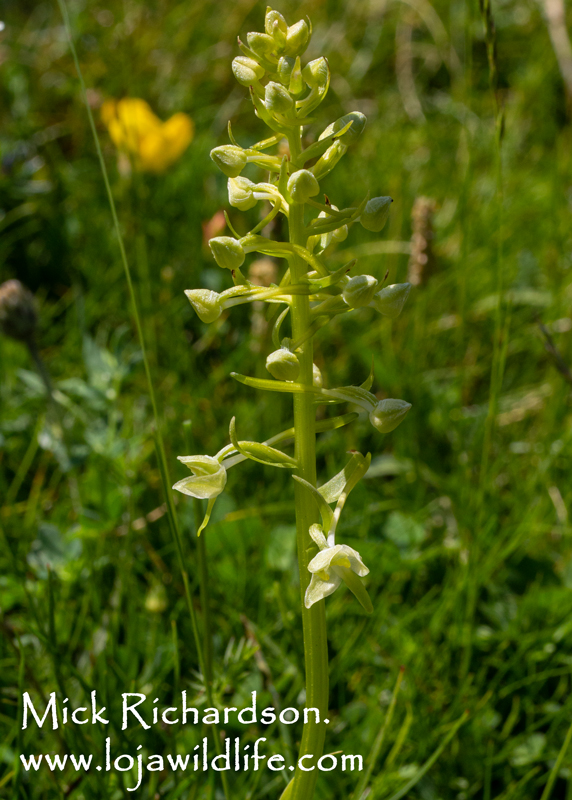 |
| Greater Butterfly Orchid (Platanthera chlorantha). |
 |
| Small Blue (Cupido minimus), showing why it's called Small Blue. |
 |
| Zygaena species. |
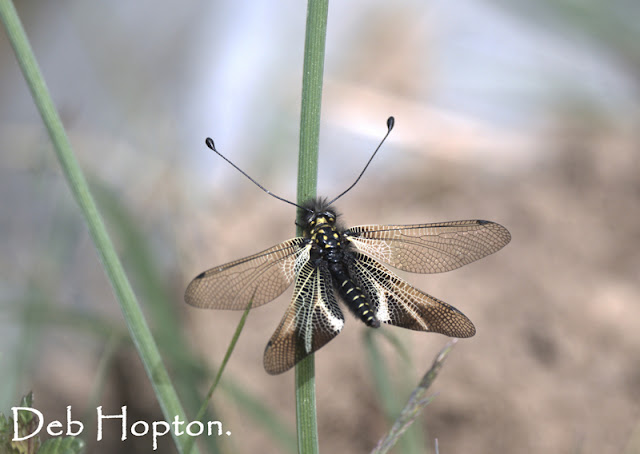 |
| Lebelloides hispanicus. |
 |
| Lebelloides hispanicus. |
During the walk back down through the woods we picked up calling
Common Firecrest (Reyezuelo Listado / Regulus ignicapilla),
Long-tailed Tit (Mito Común / Aegithalos caudatus),
One-flowered Wintergreen (Moneses uniflora) and
Painted Lady (Vanessa cardui).
 |
| One-flowered Wintergreen (Moneses uniflora). |
 |
| Painted Lady (Vanessa cardui). |
We returned to the car and dropped back down to road and continued on up the Echo valley and pulled in at the Casa forestales but decided not to eat there as the prices were a tad high, we are not tight but felt it was a bit over the top, onward again.
I had planned to stop at Barranco Boca del Infierno but all the parking was taken so we continued on seeing Carrion Crow (Corneja Negra / Corvus corone), Grey Wagtail (Lavandera Cascadena / Motacilla cinerea), Common Nightingale (Ruisenor Común / Luscinia megarhynchos) and Welsh Poppy (Papaver cambricum).
Our second try for some food was at Camping Selva de Oza where I had eaten a couple of times in the past but this time it was just so busy we gave up and decided to manage with snacks and make our way up to the upper part of the Valley.
On the way we had a couple of singing Yellowhammer, a very smart Egyptian Vulture, and on the grassy slopes and in the wet roadside flushes we found Elder-flowered, loads of Early Purple (Orchis mascula), Greater Butterfly (Platanthera chlorantha) and Common Spotted (Dactylorhiza fuchsii) incuding a hypochromic spike and Heath Spotted Orchids (Dactylorhiza maculata), Tufted Vetch (Vicia cracca) and Crosswort (Cruciata laevipes).
 |
| Greater Butterfly Orchid (Platanthera chlorantha). |
 |
| Greater Butterfly Orchid (Platanthera chlorantha). |
 |
| Heath Spotted Orchid (Dactylorhiza maculata). |
 |
| Common Spotted Orchid (Dactylorhiza fuchsii). |
 |
| Common Spotted Orchid (Dactylorhiza fuchsii). |
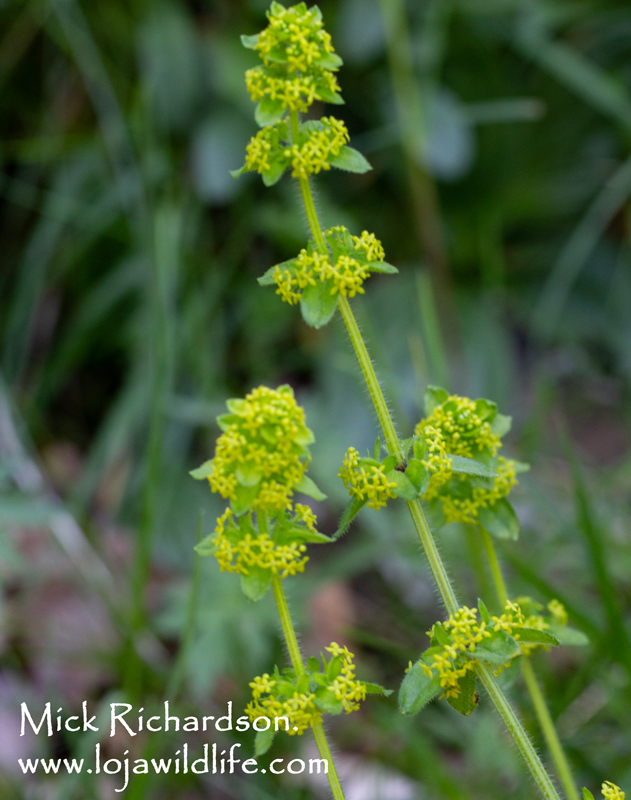 |
| Crosswort (Cruciata laevipes). |
On our way down the Valley again we found that the parking at the Barranco Boca del Infiernowas free so we parked and scanned the cliffs but apart from more of the same species of birds we didn't anything new but we did find
Pyrenean Bluebell (Brimeura amethystina),
Fringed Pink (Dianthus hyssopifolius) and a
Saxifrage Species.
 |
| Barranco Boca del Infierno. |
 |
| Saxifrage Species ??????? |
 |
| Pyrenean Bluebell (Brimeura amethystina). |
 |
| Fringed Pink (Dianthus hyssopifolius). |
It was now getting hot so we dropped back down the valley and headed back to the accommodation where Deb did us some pickles and other bits, later Ian prepared a very nice meal yet again.














































No comments:
Post a Comment